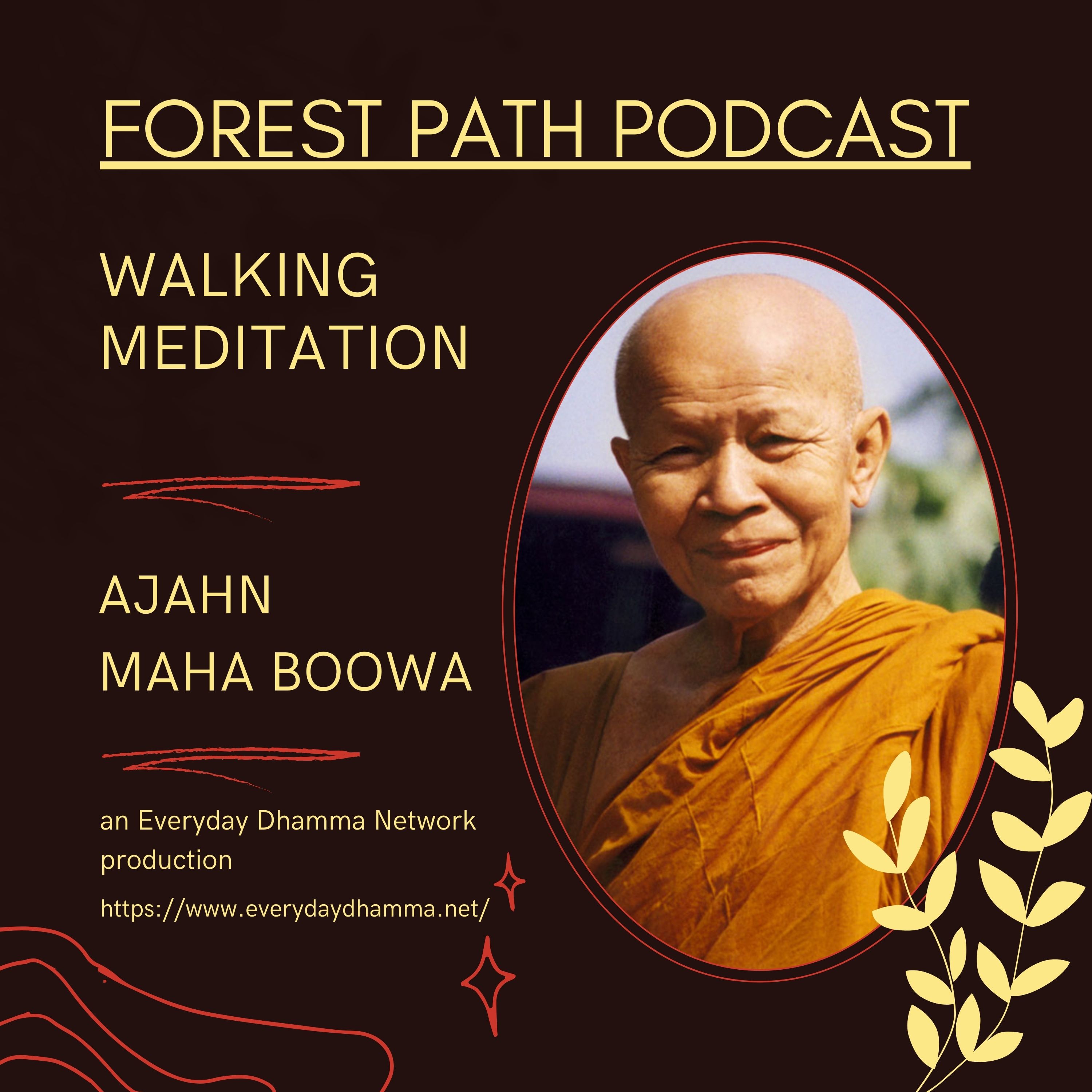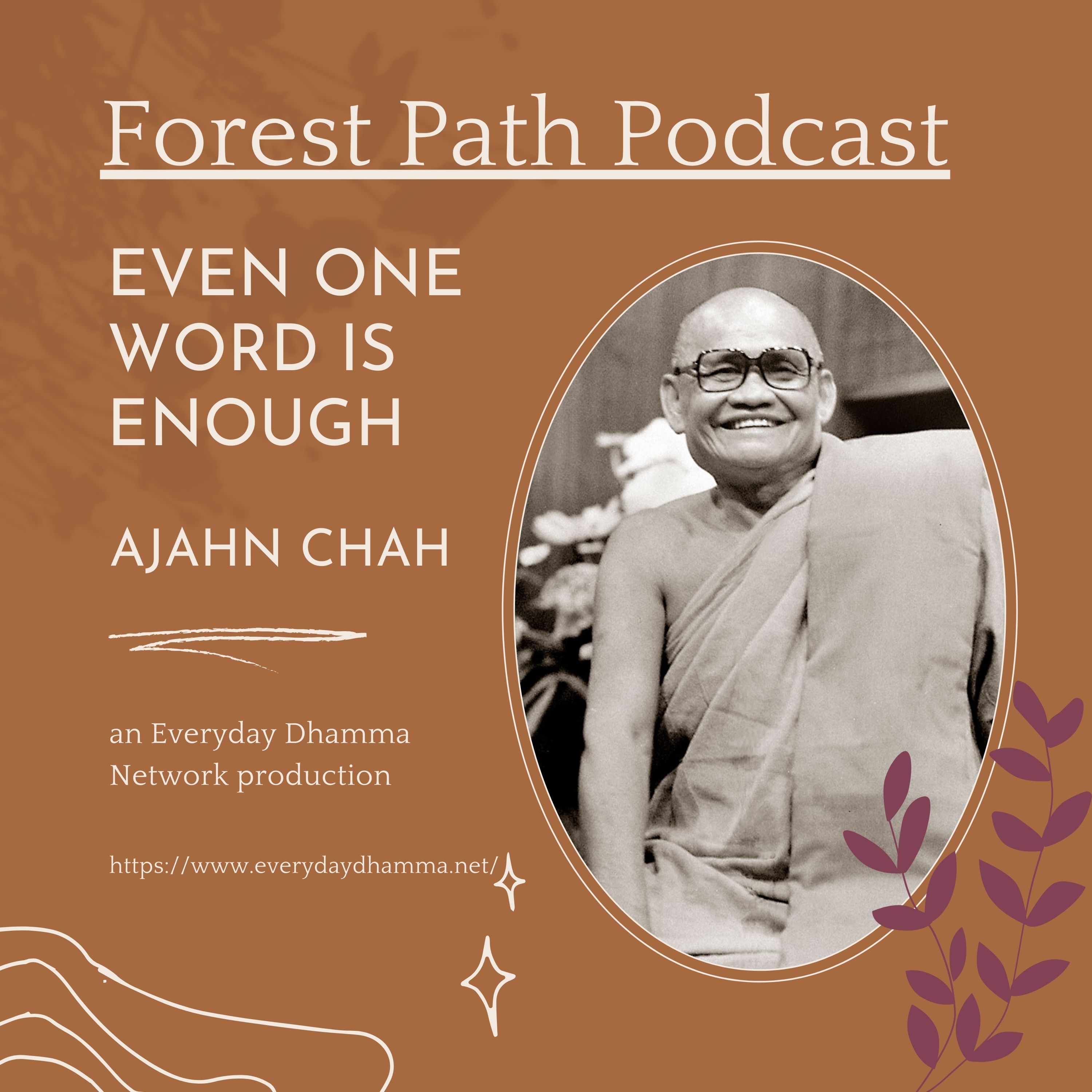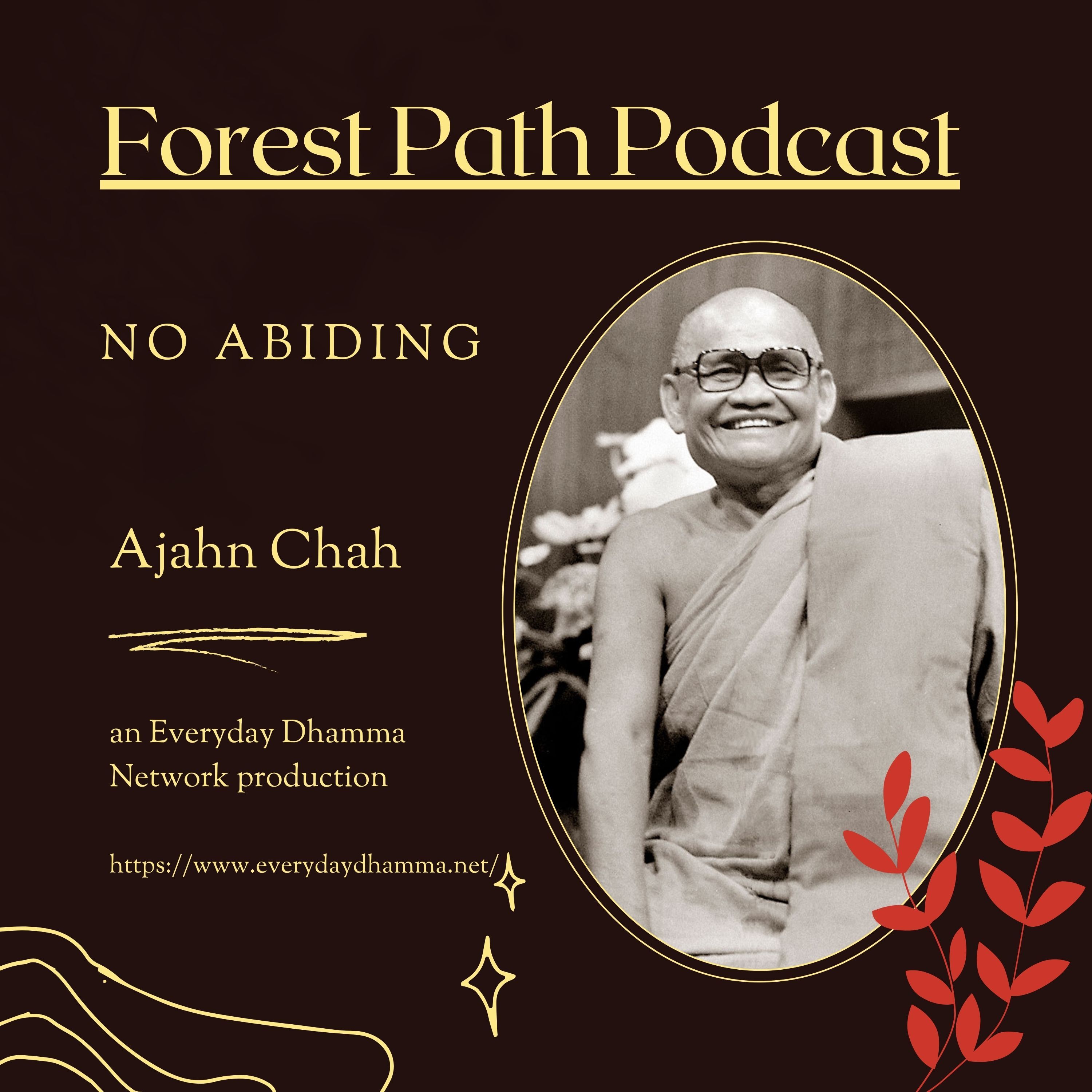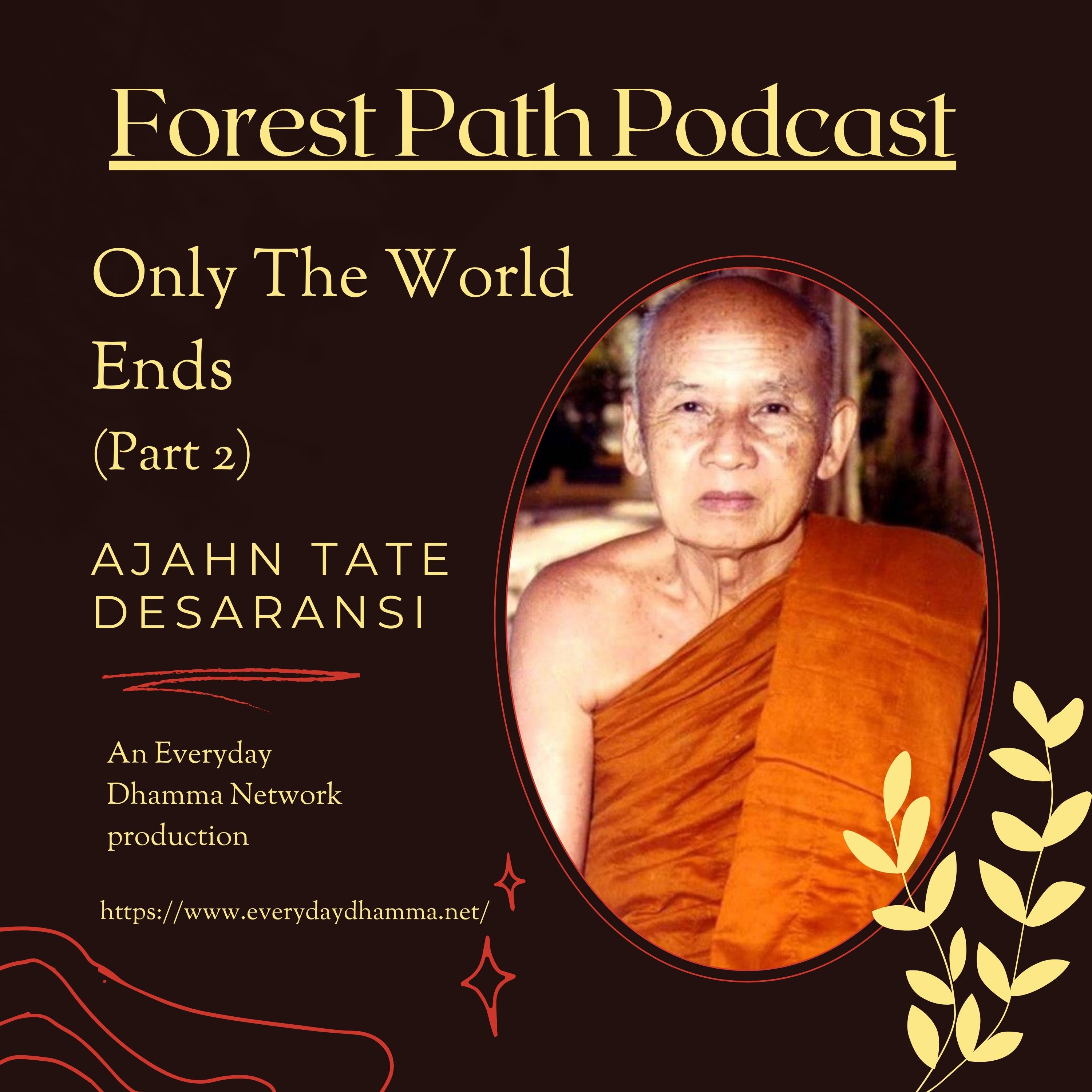Episode Transcript
WALKING MEDITATION (CAṄKAMA)
In establishing the direction of the caṅkama path, the Venerable
Ācariya Mun followed the Ariyan tradition that was used during
the Lord Buddha’s time. The path should be parallel to the
East-West, Northeast-Southwest, or Northwest-Southeast
axis, the most preferred being the East-West and then the
other two paths. As far as the North-South path is concerned,
it was not recommended and was said to be avoided.
The length of the path is not fixed and can be established
according to suitability. However, it is recommended that
the shortest path be no shorter than ten paces, even when
limited by space. The normal length is about twenty paces
and a long path extends for about twenty-five to thirty paces.
The directions recommended should be strictly followed
unless it is truly necessary or unavoidable.
The rate of walking caṅkama back and forth should be
moderate, neither too fast nor too slow, so it is pleasing to
watch and in the good manner following the tradition of the
practitioners of the Lord Buddha’s time. This is walking caṅkama
bhāvanā. There are various positions of meditation (bhāvanā)
- walking, standing, sitting, and lying down. In whichever
posture of exertion, the purpose is for the cleaning up of
the kilesas with the same kind of tool. The tool, which is the
dhamma that suits one’s character and inclination, is not
changed. Before starting to walk caṅkama, the direction
and length should be established. One should then start by
standing at one end of the path with hands in anjali (palms
together) and raised to between the eyebrows reflecting
on the blessings of the Triple Gem (the Lord Buddha, the
Dhamma, and Sangha) that one takes as the refuge and
anchor for the Heart. One should also reflect on one’s father
and mother, Upajjhāya and Ācariya, and everyone else who
has been kind and compassionate to one. Then, one should
note the purpose of one’s exertion and that one is about to
do it earnestly for that particular purpose. The hands are
then lowered and rested just under the navel, the right hand
covering the left – following the Lord Buddha’s example
when he would stand in reflection. One then radiates the Four
Brahma-Vihāras7 before starting, with gaze downwards, in
a reserved manner. One establishes sati with the citta and
with the dhamma one uses as a parikamma object or
investigates the various dhammas as one was doing in the
other postures.
One begins walking from one end of the path to the other, in
a reserved manner, having sati constantly attending to the
parikamma object or to the object under investigation. One
should not send the citta away from the work it is doing at that
time. One should not walk with the arms swinging, or walk with
the hands behind the back, nor folding the arms across the chest,
nor looking here and there, which is not a reserved manner.
One may stand at any point along the path for reflection, the
length of time depending on the subtlety of the dhamma that
one is reflecting on. One reflects until understanding clearly
before continuing to walk. Sometimes this may take nearly
an hour before one comes to a clear understanding. When one
uses a parikamma object or is doing investigation one does not
count the steps. One only counts the steps when one is using
the counting as the ārammaṇa for that exertion. In all postures
of exertion, sati is the important factor. Lacking mindfulness
means lacking exertion for that particular period. The cultivator
should place as much emphasis on sati as on the parikamma
object, for even if the parikamma object is being continuously
recited out of habit, if sati is lacking, the result – calmness of the
heart – will not arise in accordance with the intention.
The length of time for walking caṅkama is left to the practitioner
to decide for himself. In the various postures for exertion, some
may find one posture more suitable than others. However,
exerting in the other postures is also for the purpose of
changing postures and not only for the eradication of the
kilesas. This is because of the necessity of maintaining the
body, which is the tool which performs practically and usefully.
The changing of postures is suitable for the body which is
constantly at work. If it is not maintained by the various means,
the body can turn to be a menace to the owner: it will be injured
and put out of order and finally will not be able to finish the work
according to the pre-established goal.
The kammaṭṭhāna bhikkhu takes walking caṅkama as his
life’s work. Mostly, he spends an hour or more on each walk.
In the morning, after finishing the meal, he will enter the
caṅkama path and will not leave until about eleven o’clock
or midday. After a short rest between one and two o’clock
he goes again to the path to walk caṅkama until it is time to
sweep and bathe. When this is finished, he enters the path
until about eight o’clock, but, if it is not the Cold Season, he
will continue walking until about ten or eleven o’clock before
retiring to his dwelling place to carry on the practice of
samādhi-bhāvanā.
The practice of walking caṅkama and sitting in samādhi must
be done constantly, regardless of place and season, over
a long stretch of time. The kammaṭṭhāna bhikkhu’s exertion is
constantly maintained, not allowing any lapse which will give
opportunity for the kilesas to disturb and bring trouble to the
Heart. He is constantly trying to curtail them in every posture.
With this kind of effort, he comes to see some of the results
of his exertion. He will see this increasingly as he progresses.
In observing the mind and establishing mindfulness while
walking caṅkama, please do it seriously and systematically,
befitting one’s intention in seeking good things. Walking
caṅkama bhāvanā is the correct way in the search for good
things. It is blameless and praised by the sages all over the world.
One should endeavour to make the citta calm during that
time. Do not merely perform it. One will then come to see the
supreme marvel within oneself. The filth that wraps the
heart blinds one from seeing the importance of that which is
being wrapped. One is fooled into thinking that the filth itself is
important and one is totally immersed in that delusion. The
truth, concerning the renowned Buddha, Dhamma, and
Sangha of the Three Worlds, arises out of the Heart which is
both the cause and the result of the aforementioned marvel.
It is this Heart that is free from those filthy wrappings; and it
is this Heart that is either known as Buddha or Sangha,
according to the state of each possessor.
Once without the possessor, it is absolute, total Dhamma.
Then there are no terms within, like ‘citta’ or ‘Lord Buddha’,
which are just conventions (sammuti) of the highest level.
All that remains is the term ‘Dhamma’, and even this is still
only a convention of the highest level; yet it has to remain in
usage as the principal basis for the world that is still dependent
on Dhamma. When one has attained to independence, one
will then definitely come to know the term ‘Dhamma’, even if
one has never experienced it before.
It is the same with the term ‘citta.’ Everybody’s citta all over
the world is essentially the same. But there are things beyond
our normal comprehension that make our citta different. There
are various kinds of existing, inter-related conditions and
environments beyond description that are interacting. The
citta, though quite different from these things, because it is
mixed, entangled, and covered with these things, becomes
indistinguishable from them. It is covered to the point where
it is impossible to know how much each citta is being covered
by these things, and also impossible to trace where each citta
previously existed or what covers it most.
Regarding all those things under the name of kilesas or filth
as seen by all the Supreme Ones, if anyone were able, to
whatever degree, to eradicate and uproot them, then they
would, to that degree, also experience happiness: all
according to their ability in clearing them up. If it can be
cleaned to the point of purity, one is then totally free of dukkha
within the Heart and yet still exist among the khandhas that
one still possesses, just as the Lord Buddha and Arahant
disciples who attained to Enlightenment and realized Dhamma.
They all experienced the bliss of deliverance (vimutti sukha)
right then and there without depending on time and place.
All that is required is for the kilesas, the enemy of the mind and
Heart, to totally disappear, and therefore it is only the kilesas
that obstruct the citta from attaining magga, phala, and
Nibbāna. There is nothing else that has this power of
obstruction.
The teachings of Dhamma, therefore, concentrate on the heart,
which is the hiding-place of all the defilements, having the prac-
tical dhammas of sīla, samādhi, and paññā 8 as the principal
basis among the Dhamma for correcting and clearing.
In summary: if one finds walking caṅkama suitable and
experiences calm and gains various kinds of upāya (skillful
means) to a greater degree than when sitting in samādhi, one
should then walk more than sit. But if the citta gains better
results in sitting, one should sit more than walk. But one
should not exclude the changing of body postures because it
is very important for the body, which is the tool that performs
the work.
Both of these methods are the means for the destruction of
the kilesas, the things that accumulate lives, existences and all
the kinds of dukkha within the Heart. Please give attention to
your heart, which is also the essence of the world. The world
and oneself will then live in harmony and not in turmoil
and trouble. One is protected because the mind is well trained.
This is better than not having any protection at all. When it
is time for the dissolution of the body (khandhas), one can
depend on the inner sanctuary of virtue that has been built up.
Worldly beings come and go according to their good and
bad kamma. They experience the results of happiness and
suffering all the time. There has never been a single being
that has escaped experiencing undesirable results. Even in
the human world, we can fully see both in ourselves and in
others, and with the animals, that all experience some
happiness and some pain, here and there, now and then.
The training in the way of virtue, which is having sīla, samādhi
and paññā as the Heart’s sanctuary, is something which
the cultivator can experience in the present, today, and in this
life, without any doubt – just as in the Lord Buddha’s time.
This discussion on the methods of walking caṅkama and
sitting in samādhi-bhāvanā has been treated generally and
is practical both for householders and those ordained.
The primary result of walking caṅkama and sitting in samādhi-
bhāvanā is calmness of the citta. When the citta converges,
it is singular, having only one ārammaṇa.
The secondary results vary according to each type of
character. The practitioner should not, therefore, be concerned
about the minor results which one hears about from other
practitioners, some of whom will describe the experiences they
have had, like for example, seeing various kinds of visions
(nimitta).
One should be concerned with the primary result: the state
of calm when the citta converges. Generally, this is the
essential result of practising samādhi. One who exerts and
endeavours, regardless of profession – householder or
ordained – will definitely come to see the marvel of the heart
from samādhi-bhāvanā. The news that one reads about those
enlightened disciples will eventually become the news about
oneself; for the kilesas, the bad deeds, and the dhamma,
the device for overcoming the kilesas, are impartial with
everyone, both in those days and in the present.
One who engages correctly (sāmīci-kamma) – the right
practice of samādhi which gives appropriate results, like
those experienced by the Noble Ones – will also experience
those same results. The important thing is not to speculate
more about the time and place of magga, phala, and Nibbāna
than about the actual practice, with the magga, the suitable
dhamma, as the means. This is the device that totally
eradicates the kilesas from within the Heart, together with
the heap of dukkha. This path (magga) is the dhamma that
directly counters the kilesas and has been from that time up
to the present day without change. Please use it to correct the
citta – which is the origin and home of all the various kinds of
defilements – until one comes to see fully that the Heart has
changed from being the container for kilesas to the container
for dhammas, gradually, until the whole Heart becomes
Dhamma.
Once the Heart is wholly Dhamma, no matter where one lives
the ‘dukkha within the Heart’ will never appear, only the dukkha
of the body (which is the true home of dukkha). The khandhas
are just khandhas; and dukkha is just dukkha. They remain so
until the end, when they cease to be khandhas and dukkha.
The ignorance (avijjā) that previously was all powerful over
the Heart loses its powerful grip at the time when the heart
becomes wholly Dhamma. This is the work of Dhamma. It has
an ending. One can gain deliverance, unlike the work of avijjā
which spreads infinitely all over the world of saṁsāra without
ever coming to an end. Even if this latter work is done for ages
upon ages it will continue to revolve eternally.
But there is one work that has the possibility of an ending. One
does not have to revolve with the burden of dukkha forever;
and one who has experienced both of these ‘works’ will know
their contrasting results: like two different worlds. If one were
to choose with intelligence, which would one choose? One can
see with this that there is a way out. One does not have to be
entangled with this revolving work to the point where one forgets
to pay attention to the treasures of Dhamma that one could have
for oneself in the future.




